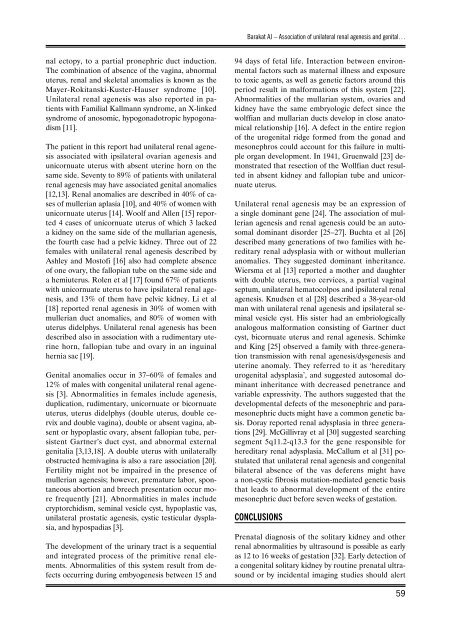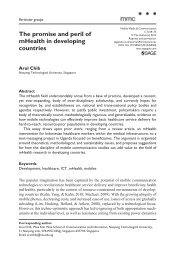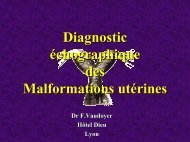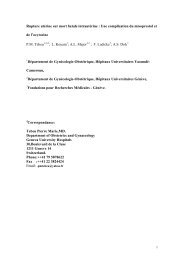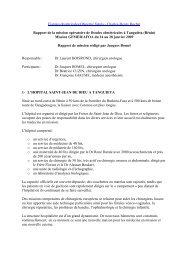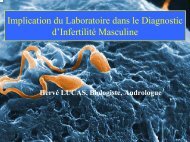Association of unilateral renal agenesis and genital anomalies
Association of unilateral renal agenesis and genital anomalies
Association of unilateral renal agenesis and genital anomalies
You also want an ePaper? Increase the reach of your titles
YUMPU automatically turns print PDFs into web optimized ePapers that Google loves.
Barakat AJ – <strong>Association</strong> <strong>of</strong> <strong>unilateral</strong> <strong>renal</strong> <strong>agenesis</strong> <strong>and</strong> <strong>genital</strong>…nal ectopy, to a partial pronephric duct induction.The combination <strong>of</strong> absence <strong>of</strong> the vagina, abnormaluterus, <strong>renal</strong> <strong>and</strong> skeletal <strong>anomalies</strong> is known as theMayer-Rokitanski-Kuster-Hauser syndrome [10].Unilateral <strong>renal</strong> <strong>agenesis</strong> was also reported in patientswith Familial Kallmann syndrome, an X-linkedsyndrome <strong>of</strong> anosomic, hypogonadotropic hypogonadism[11].The patient in this report had <strong>unilateral</strong> <strong>renal</strong> <strong>agenesis</strong>associated with ipsilateral ovarian <strong>agenesis</strong> <strong>and</strong>unicornuate uterus with absent uterine horn on thesame side. Seventy to 89% <strong>of</strong> patients with <strong>unilateral</strong><strong>renal</strong> <strong>agenesis</strong> may have associated <strong>genital</strong> <strong>anomalies</strong>[12,13]. Renal <strong>anomalies</strong> are described in 40% <strong>of</strong> cases<strong>of</strong> mullerian aplasia [10], <strong>and</strong> 40% <strong>of</strong> women withunicornuate uterus [14]. Woolf <strong>and</strong> Allen [15] reported4 cases <strong>of</strong> unicornuate uterus <strong>of</strong> which 3 lackeda kidney on the same side <strong>of</strong> the mullarian <strong>agenesis</strong>,the fourth case had a pelvic kidney. Three out <strong>of</strong> 22females with <strong>unilateral</strong> <strong>renal</strong> <strong>agenesis</strong> described byAshley <strong>and</strong> Most<strong>of</strong>i [16] also had complete absence<strong>of</strong> one ovary, the fallopian tube on the same side <strong>and</strong>a hemiuterus. Rolen et al [17] found 67% <strong>of</strong> patientswith unicornuate uterus to have ipsilateral <strong>renal</strong> <strong>agenesis</strong>,<strong>and</strong> 13% <strong>of</strong> them have pelvic kidney. Li et al[18] reported <strong>renal</strong> <strong>agenesis</strong> in 30% <strong>of</strong> women withmullerian duct <strong>anomalies</strong>, <strong>and</strong> 80% <strong>of</strong> women withuterus didelphys. Unilateral <strong>renal</strong> <strong>agenesis</strong> has beendescribed also in association with a rudimentary uterinehorn, fallopian tube <strong>and</strong> ovary in an inguinalhernia sac [19].Genital <strong>anomalies</strong> occur in 37–60% <strong>of</strong> females <strong>and</strong>12% <strong>of</strong> males with con<strong>genital</strong> <strong>unilateral</strong> <strong>renal</strong> <strong>agenesis</strong>[3]. Abnormalities in females include <strong>agenesis</strong>,duplication, rudimentary, unicornuate or bicornuateuterus, uterus didelphys (double uterus, double cervix<strong>and</strong> double vagina), double or absent vagina, absentor hypoplastic ovary, absent fallopian tube, persistentGartner’s duct cyst, <strong>and</strong> abnormal external<strong>genital</strong>ia [3,13,18]. A double uterus with <strong>unilateral</strong>lyobstructed hemivagina is also a rare association [20].Fertility might not be impaired in the presence <strong>of</strong>mullerian <strong>agenesis</strong>; however, premature labor, spontaneousabortion <strong>and</strong> breech presentation occur morefrequently [21]. Abnormalities in males includecryptorchidism, seminal vesicle cyst, hypoplastic vas,<strong>unilateral</strong> prostatic <strong>agenesis</strong>, cystic testicular dysplasia,<strong>and</strong> hypospadias [3].The development <strong>of</strong> the urinary tract is a sequential<strong>and</strong> integrated process <strong>of</strong> the primitive <strong>renal</strong> elements.Abnormalities <strong>of</strong> this system result from defectsoccurring during embyogenesis between 15 <strong>and</strong>94 days <strong>of</strong> fetal life. Interaction between environmentalfactors such as maternal illness <strong>and</strong> exposureto toxic agents, as well as genetic factors around thisperiod result in malformations <strong>of</strong> this system [22].Abnormalities <strong>of</strong> the mullarian system, ovaries <strong>and</strong>kidney have the same embryologic defect since thewolffian <strong>and</strong> mullarian ducts develop in close anatomicalrelationship [16]. A defect in the entire region<strong>of</strong> the uro<strong>genital</strong> ridge formed from the gonad <strong>and</strong>mesonephros could account for this failure in multipleorgan development. In 1941, Gruenwald [23] demonstratedthat resection <strong>of</strong> the Wollfian duct resultedin absent kidney <strong>and</strong> fallopian tube <strong>and</strong> unicornuateuterus.Unilateral <strong>renal</strong> <strong>agenesis</strong> may be an expression <strong>of</strong>a single dominant gene [24]. The association <strong>of</strong> mullerian<strong>agenesis</strong> <strong>and</strong> <strong>renal</strong> <strong>agenesis</strong> could be an autosomaldominant disorder [25–27]. Buchta et al [26]described many generations <strong>of</strong> two families with hereditary<strong>renal</strong> adysplasia with or without mullerian<strong>anomalies</strong>. They suggested dominant inheritance.Wiersma et al [13] reported a mother <strong>and</strong> daughterwith double uterus, two cervices, a partial vaginalseptum, <strong>unilateral</strong> hematocolpos <strong>and</strong> ipsilateral <strong>renal</strong><strong>agenesis</strong>. Knudsen et al [28] described a 38-year-oldman with <strong>unilateral</strong> <strong>renal</strong> <strong>agenesis</strong> <strong>and</strong> ipsilateral seminalvesicle cyst. His sister had an embriologicallyanalogous malformation consisting <strong>of</strong> Gartner ductcyst, bicornuate uterus <strong>and</strong> <strong>renal</strong> <strong>agenesis</strong>. Schimke<strong>and</strong> King [25] observed a family with three-generationtransmission with <strong>renal</strong> <strong>agenesis</strong>/dysgenesis <strong>and</strong>uterine anomaly. They referred to it as ‘hereditaryuro<strong>genital</strong> adysplasia’, <strong>and</strong> suggested autosomal dominantinheritance with decreased penetrance <strong>and</strong>variable expressivity. The authors suggested that thedevelopmental defects <strong>of</strong> the mesonephric <strong>and</strong> paramesonephricducts might have a common genetic basis.Doray reported <strong>renal</strong> adysplasia in three generations[29]. McGillivray et al [30] suggested searchingsegment 5q11.2-q13.3 for the gene responsible forhereditary <strong>renal</strong> adysplasia. McCallum et al [31] postulatedthat <strong>unilateral</strong> <strong>renal</strong> <strong>agenesis</strong> <strong>and</strong> con<strong>genital</strong>bilateral absence <strong>of</strong> the vas deferens might havea non-cystic fibrosis mutation-mediated genetic basisthat leads to abnormal development <strong>of</strong> the entiremesonephric duct before seven weeks <strong>of</strong> gestation.CONCLUSIONSPrenatal diagnosis <strong>of</strong> the solitary kidney <strong>and</strong> other<strong>renal</strong> abnormalities by ultrasound is possible as earlyas 12 to 16 weeks <strong>of</strong> gestation [32]. Early detection <strong>of</strong>a con<strong>genital</strong> solitary kidney by routine prenatal ultrasoundor by incidental imaging studies should alert59


